The Emery Theatre - The Seven Year Itch
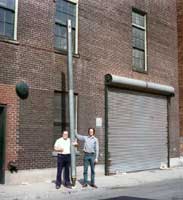 Once the organ was completely removed from the Albee and safely stored in the basement of Emery Auditorium, plans were begun for its reinstallation. At first it was thought that the organ could simply be reassembled with some refurbishing, and overly optimistic dates for its completion were published. As the work progressed, however, it was soon evident that nothing short of a complete rebuilding would produce a first class instrument, arid this was the course the chapter decided upon.
Once the organ was completely removed from the Albee and safely stored in the basement of Emery Auditorium, plans were begun for its reinstallation. At first it was thought that the organ could simply be reassembled with some refurbishing, and overly optimistic dates for its completion were published. As the work progressed, however, it was soon evident that nothing short of a complete rebuilding would produce a first class instrument, arid this was the course the chapter decided upon.
Since no organ had ever been installed or contemplated in Emery Auditorium, there were no existing chambers, making it necessary to construct new ones. Plans were made by member Bob Klensch, who is a general contractor, for chambers to be located directly on the stage, as had initially been agreed upon by OCAS-OMI.
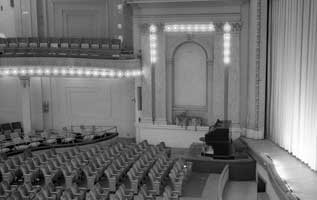 When UC took over, the chapter was told to design chambers for placement in the walls on either side of the stage, in order to leave the stage open and fully usable. A test hole was cut in one of the walls to determine the feasibility of chamber placement there, but the wall was found to be too full of structural iron to allow chamber construction. It was decided that the next best place would be in the wings at the sides of the first balcony, and plans were drawn up for that location. After further study, it was found that a balcony installation posed a number of problems also, and eventually UC agreed to locating the chambers on the stage as originally planned.
When UC took over, the chapter was told to design chambers for placement in the walls on either side of the stage, in order to leave the stage open and fully usable. A test hole was cut in one of the walls to determine the feasibility of chamber placement there, but the wall was found to be too full of structural iron to allow chamber construction. It was decided that the next best place would be in the wings at the sides of the first balcony, and plans were drawn up for that location. After further study, it was found that a balcony installation posed a number of problems also, and eventually UC agreed to locating the chambers on the stage as originally planned.
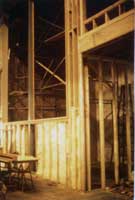 The chambers were built in 1974 by Bob Klensch, who did the job at cost through his company. In spite of that, five years had elapsed since the first chamber plans were made, and due to inflation, price increases, and modifications to the original design, the final cost came to nearly five times the
The chambers were built in 1974 by Bob Klensch, who did the job at cost through his company. In spite of that, five years had elapsed since the first chamber plans were made, and due to inflation, price increases, and modifications to the original design, the final cost came to nearly five times the 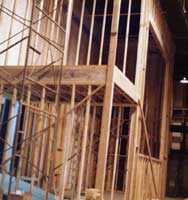 original estimate. This surely would have bankrupted the chapter, had it not been for the generosity of Jack and Joan Strader, who saw the problem and paid the bill as a gift to the university. The chambers are exceptionally large and uncrowded, making it very easy to install and maintain the organ, as well as allowing space for additional ranks to be added later. Everything in the chambers is readily accessible.
original estimate. This surely would have bankrupted the chapter, had it not been for the generosity of Jack and Joan Strader, who saw the problem and paid the bill as a gift to the university. The chambers are exceptionally large and uncrowded, making it very easy to install and maintain the organ, as well as allowing space for additional ranks to be added later. Everything in the chambers is readily accessible.
 There are three chambers, main, solo, and percussion. The percussion chamber is located above and between the main and solo chambers. The main and solo are each twenty-two feet wide and have a total of seventy-two swell shades, so there is nothing in the way of the sound when all the shades are open. A master plan for the organ's design and reinstallation was prepared by Herbert Wottle and E.S. "Tote" Pratt. The plan calls for the eventual addition of seven ranks to the original nineteen, for a total of twenty-six. Wurlitzer chests were acquired for the extra ranks and have been included in the initial installation so that the additional pipes may be added later without disturbing any of the original pipework.
There are three chambers, main, solo, and percussion. The percussion chamber is located above and between the main and solo chambers. The main and solo are each twenty-two feet wide and have a total of seventy-two swell shades, so there is nothing in the way of the sound when all the shades are open. A master plan for the organ's design and reinstallation was prepared by Herbert Wottle and E.S. "Tote" Pratt. The plan calls for the eventual addition of seven ranks to the original nineteen, for a total of twenty-six. Wurlitzer chests were acquired for the extra ranks and have been included in the initial installation so that the additional pipes may be added later without disturbing any of the original pipework.
 One rank has been added so far, a 16' thirty-two pipe pedal Violone from the Austin organ in the Liberty Theatre in Covington, Kentucky. It is believed that this is one of the few theatre organs to have an independent 16' pedal rank. The rank is a gift of member Herbert Merritt. The console, when removed from the Albee theatre, was in the usual poor shape of such consoles, with multiple coats of paint, dents and gouges, and plenty of dirt.
One rank has been added so far, a 16' thirty-two pipe pedal Violone from the Austin organ in the Liberty Theatre in Covington, Kentucky. It is believed that this is one of the few theatre organs to have an independent 16' pedal rank. The rank is a gift of member Herbert Merritt. The console, when removed from the Albee theatre, was in the usual poor shape of such consoles, with multiple coats of paint, dents and gouges, and plenty of dirt.
It has been refinished to look like new in ebony, by Hubert Shearin, who contributed the job through his company, Manual Arts Furniture. The console sits on a red carpeted platform in front of the stage on the left side, in approximately the same position it had in the Albee. The stop tabs for the original nineteen ranks have been retained on the curved stoprails without change, with the exception of the addition of piano stops where the swell indicators were located. A new back rail was designed by Herb Wottle and includes the original back rail stops plus the ones  for the additional ranks as they are added. The console is ready for the extra ranks, with the stop tabs installed. The new back rail is equipped with quick disconnects for easy servicing. The console has a new solid-state cancel system, designed and built by Herb Wottle. It features eight independent cancel actions: all trems off, piano off, traps off, four manual cancels, and general cancel.
for the additional ranks as they are added. The console is ready for the extra ranks, with the stop tabs installed. The new back rail is equipped with quick disconnects for easy servicing. The console has a new solid-state cancel system, designed and built by Herb Wottle. It features eight independent cancel actions: all trems off, piano off, traps off, four manual cancels, and general cancel.
There are now a total of eleven regulators. Additional tremulants have been added for greater flexibility and tonal variety, so that the organ now has nine separately usable trems. Of course, the organ has been completely releathered and all rubber cloth has been replaced. All metal parts on the console and toy counter have been newly chrome plated. An additional expression pedal has been added for the percussion chamber, which was not in the original Albee installation. A few modifications and improvements have been made as the organ was rebuilt. Two additional regulators have been added so that all 16' offset chests are on untremmed regulators for more effective tremulants on the manual chests and better wind supply under heavy demand conditions.
Chapter Chairman Hubert Shearin estimates that approximately 20,000 volunteer man-hours have been spent on the organ over a period of seven years. The work has been done mostly on Saturdays by a dedicated crew of members, including Phil and Blanche Underwood, Glenn Merriam, Spencer Avery, Bill Ahlert, Ed Rose, Ed Dooley, Don Campbell, Carol Powers, Art Kessler, Henry Arleth and Art Havlovic.
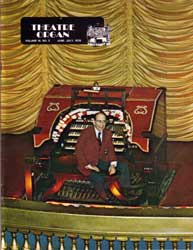 Others who have helped include Sue Pratt, Florence Kipp, Carl Pratt, Joe Deifel, Bill Schott, Ken Kramer and Webb Bond. In addition, other chapter members have helped from time to time. Herb Merritt is the crew chief for the solo and percussion chambers and John Scott is in charge of the main chamber installation. Both have done extensive work in laying out and installing metal windlines and generally overseeing all work in the chambers. Hubert Shearin has had made whatever new wood parts were needed. In addition to working on the organ, Blanche Underwood has faith fully contributed lunch for the group each week and has photographed the entire project, providing a complete record of the progress.
Others who have helped include Sue Pratt, Florence Kipp, Carl Pratt, Joe Deifel, Bill Schott, Ken Kramer and Webb Bond. In addition, other chapter members have helped from time to time. Herb Merritt is the crew chief for the solo and percussion chambers and John Scott is in charge of the main chamber installation. Both have done extensive work in laying out and installing metal windlines and generally overseeing all work in the chambers. Hubert Shearin has had made whatever new wood parts were needed. In addition to working on the organ, Blanche Underwood has faith fully contributed lunch for the group each week and has photographed the entire project, providing a complete record of the progress.
Tote Pratt, as chairman of the project, has given unstintingly of his time and energy. Howard Van Styn, of the OCAS staff, has been a great help so many times that it is impossible to keep track of them. His contribution to, and interest in, the success of the project has been much appreciated by the chapter. Appreciation is also due to Joe Alexander, who, as RKO Division Manager, was most helpful to the chapter in its presentation of silent film shows at the Albee and in the removal of the organ from the theatre.
While the wreching ball was making it's way to the Albee Theatre in 1977, the soul of it was getting ready to sing at the Emery Theatre.
NEXT, the Emery Dedication
Blanche Underwood's Photographic Accounts
To see any large photo on this page, click on any image.
Hit the BACKSPACE key to return to this page.
Media files may open either in Windows Media Player or QuickTime.
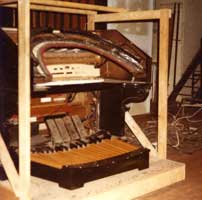
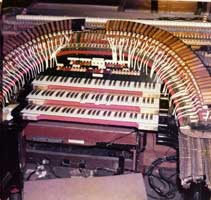
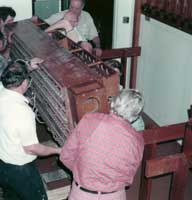
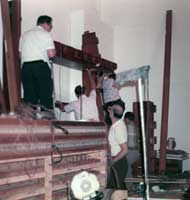 —
—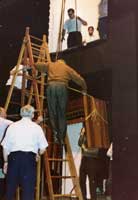 —
—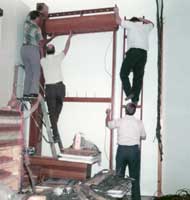
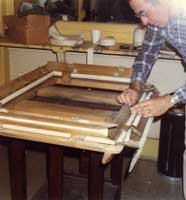 —
—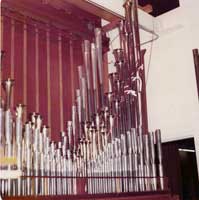 —
—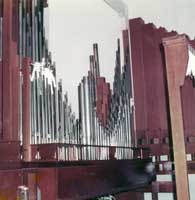
Footnotes:
Written by Michael Detroy as it appeared in the June-July 1976 issue of Theatre Organ magazine.
The official journal of the American Theatre Organ Society.
Organ construction photos were taken by Blanche Underwood.
Photos of the console and left side of the Emery Theatre was taken by Michael Detroy.
Marilyn "Bubbles" (Libbin) McClain performs Syncopated Clockon the
RKO Albee Mightly WurliTzer Pipe Organ at the Emery Theatre in 1979.

